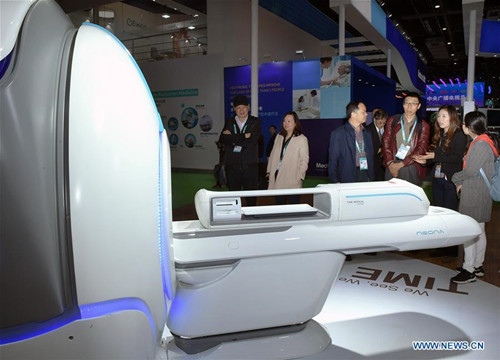Medical technology: from lagging behind to leading

Visitors view NEONA neonatal MRI system at the Medical Equipment & Health Care Products area of the first China International Import Expo (CIIE) in Shanghai, east China, Nov. 8, 2018. (Xinhua/Li He)
Stethoscopes, thermometers and sphygmomanometers were doctors’ only equipment to check patients four decades ago, and now China has surgical robots. The reduction in the gap between China’s medical science and the highest levels around the world was made by the diligence and intelligence of many Chinese medical scientists and technologists.
Five winners of the Highest Science and Technology Award in the medical field, namely Wu Mengchao, Wang Zhongcheng, Wang Zhenyi, HouYunde, and 2015 Nobel laureate in Physiology or Medicine TuYouyou, have not only saved a great many lives but have also honored China.
Hou Yunde, winner of the highest scientific award issued by the Chinese Academy of Sciences in 2018, is a virus specialist. He said he thinks that the study of viruses is an attempt to figure out the origin of life as the virus is the smallest life unit in existence.
Hou started China’s research and development of gene-engineering medicines. To date, eight of them have saved tens of millions of lives and generated economic outcomes valued in billions of yuan. The most prominent one is α1b, a recombinant human interferon, which is affordable for Chinese and able to defend common viruses.
Hou has optimized a system to prevent and control emergent and acute infectious diseases. It helps to identify 300 known and unknown pathogeneses in just 72 hours and has successfully dealt with several major epidemics in the past decade.
Hou said that preventing and controlling infectious and epidemic diseases is crucial for national health.
Average life expectancy, infant mortality rates and maternal mortality rates are a nation’s core measurements of people’s health according to the WHO. China has ranked better than the average level of middle and high income countries in the health of infants and mothers during the past four decades.
In 1988, the Chinese mainland’s first test-tube baby was born in Peking University Third Hospital (PUTH). Although this was a landmark event for China, it still lagged a decade behind the world’s first test-tube baby. Qiao Jie, the president of PUTH, deeply understood the backward situation and led other medical scientists and technologists to explore the reasons of infertility and improve the assisted reproductive technology (ART). Currently, 200,000 babies have been delivered through ART and the skill level has already met that of the average level in advanced countries.
Qiao said the reform and opening-up brought a terrific opportunity to China’s medical development and innovation.
Pharmaceuticals are indispensable weapons of doctors and patients to combat diseases and are closely connected to economic development. Jiangsu Hengrui Medicine has done a great job in the sector. Started with an annual profit of just 80,000 yuan ($11,875), it is currently a leading company of medicine innovation and R&D with a market value of hundreds of billions of yuan.
The core step in boosting China’s medicine industry development is to cultivate the independent innovation ability and international competitiveness of national medicine companies, Sun Piaoyang, president of the company said at a meeting with some private entrepreneur in Beijing on Nov 1.
Sun said that making affordable and reliable pharmaceuticals has been the common dream of Chinese medicine producers in the past 40 years.
The quality and accessibility ranking of China’s medical care was up to No 48 in 2016 compared with No 110 in 1990, according to Lancet, an internationally authoritative medical magazine. The range of the advancement was the third in the world.


